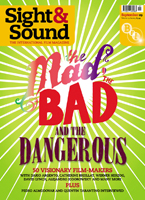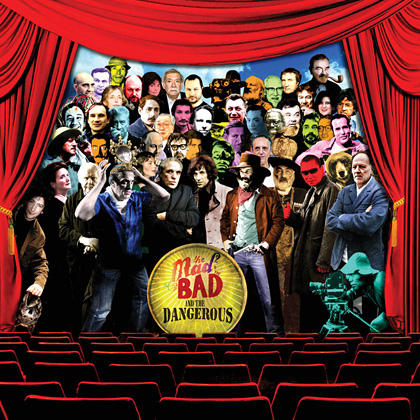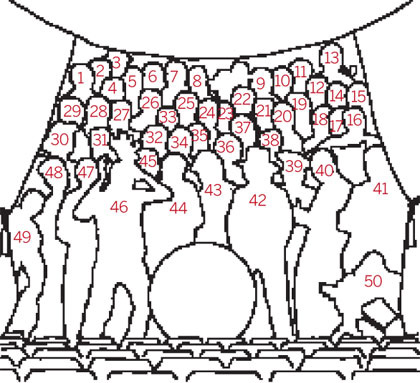Primary navigation


KEY 1 Gaspar Noé 2 Jerzy Skolimowski 3 Nakagawa Nobuo 4 Claire Denis 5 Dusan Makavejev 6 Vera Chytilová 7 Raúl Ruiz 8 Lars von Trier 9 Jan Svankmajer 10 Suzuki Seijun 11 Walerian Borowczyk 12 Wakamatsu Koji 13 Fernando Arrabal 14 Catherine Breillat 15 Paul Verhoeven 16 Kenneth Anger 17 Masumura Yasuzo 18 Andrzej Zulawski 19 Alexei Guerman 20 Djibril Diop Mambéty 21 Ma-Xu Weibang 22 Wojciech Has 23 Glauber Rocha 24 Guy Maddin 25 Tsui Hark 26 Josef von Sternberg 27 David Lynch 28 Alexei Balabanov 29 Tsukamoto Shinya 30 Luis Buñuel 31 Mario Bava 32 Cecil B. DeMille 33 Imamura Shohei 34 Ritwik Ghatak 35 Edgar G. Ulmer 36 Ed Wood 37 Tod Browning 38 Dario Argento 39 Sergei Paradjanov 40 Miike Takashi 41 Werner Herzog 42 Alejandro Jodorowsky 43 Donald Cammell 44 Abel Ferrara 45 Jane Arden 46 Federico Fellini 47 Ken Russell 48 Sally Potter 49 Richard Stanley 50 Ogawa Shinsuke

They make films that are uncategorisable, in which cinematic language, taste and even reality itself are bent to their will. Mark Cousins enters the revolutionary worlds of the 'Wild Bunch'
Picture yourself in a gigantic kineopolis, a repository of all films from all nations, an Alexandrian library of movies. As you walk through this cavernous San Simeon, fancy - if you will - that the movies call out to you from cans on shelves and servers in niches, like cockatiels in eucalyptus trees and monkeys in banyans. Which films would have the loudest, most distinctive calls? Not, surely, those by William Wyler, Jean Renoir or Robert Bresson - Bazin's boys - or by Stephen Frears, Jia Zhangke, Margarethe von Trotta, Hou Hsiao-hsien, George Cukor or Ang Lee. No, above these we'd hear the stylistic roar of Jodorowsky's Santa Sangre, Tsukamoto's Tetsuo, Browning's Freaks, von Sternberg's The Devil Is a Woman, every frame of Fellini, the imagistic Tourette's of von Trier, the fingernails on a blackboard that is Zulawski…
And then you notice that these first-raised voices you hear in the kineopolis are all from those who scuba down into the unconscious. None of this first lot are much interested in the rational or social. The same could be said for David Lynch, Catherine Breillat and Miike Takashi - not the loudest kids on the block sonically, but boy do their images from down there echo upwards.
We're talking here about 'wild' film-makers. They come from all decades and places, but prick up your ears to them in the kineopolis and you start to notice some trends. Think of the production values of the films of Cecil B. DeMille, Marcel L'Herbier, Erich von Stroheim, Giovanni Pastrone in Cabiria or Buster Keaton in The General and you realise that the 1910s and 1920s were years when there was a flight from tameness in cinema. Notice the megaphone passion of Ritwik Ghatak, the intensity of longing in Gulzar (who got a Best Original Song Oscar for Slumdog Millionaire after decades of writing and directing great films) and the fact that many Indian films derive from what were called 'mythologicals' - and can't resist lifting off the ground of realism into the gulf stream of musical fantasy - and you clock that most of Hindi (what's called Bollywood) cinema has a wild excess of expression.
Then consider that swollen period of film history, the 1950s, when Youssef Chahine in Egypt, Kenneth Anger in the USA, Xie Jin in China and Ghatak (again) in India were pump-priming their movies with rage, and you might decide that liberation movements around the world - not to mention Eisenhowerian conformism - caused film form to scream. A decade or so later, the new permissiveness allowed existing wildies to go further (think Pasolini with Salò) and opened the floodgates for Dusan Makavejev, Walerian Borowczyk, Ken Russell, Mario Bava and Masumura Yasuzo. From the early 1970s, their danse macabre flickered and frolicked in grindhouses and the midnight-movie fleapits of New York and at the Scala in London. Finally, hark how some directors - Pasolini, Senegal's Djibril Diop Mambéty, Japanese documentarist Ogawa Shinsuke and their latter-day patron saint Werner Herzog - all believe that society is so stale or doomed that they yell about Rousseauian sublime worlds.
But do these film-makers have anything in common beyond the fact of their attention grabbing? I think they do. First, they are mostly impatient with the Aristotelian unities of time and space - bugger that. They prefer their settings to be baroque, extended into multiple realms. Second, they're not ones for categories - think of the bisexuality and populism of Paul Verhoeven, or Baz Luhrmann's masala of disco, Shakespeare, Bollywood and Sergio Leone. Third, they're all people for whom the birth of an idea in the mind's eye is basically a violent or feverish event. Unlike the great movies of, say, Cukor, Ford, Hawks, Rouch and the great Indian director Tapan Sinha, who died in January, form is not servile to content for them. Rather, it is monstrous - “exploding, like the eruption of Mount St Helens”, as David Lynch once told me in an interview. Each of these 'wild' directors has a psychic energy that is manic to a degree and might well be fuelled by sexual rage, or colonial exploitation, or a Marxist hatred of consumerism, or a fear of modernity or the body (Tsukamoto Shinya, we salute you) - or by historical events such as Partition. But that energy in turn fuels a will to form that is so feral it makes the act of film-making look feverish - and makes fairness to content seem like an anaemic propriety.
Such energy makes for electrifying moviegoing, but if these Mr Hydes have in common the energy of their mental activity or the intensity of their reaction to society, then it should be made clear that neither of these things is purely filmic. Pasolini's writing is just as hysterical as his film-making; our hallucinated cage rattlers have much in common with R.D. Laing, Jean-Jacques Rousseau, Edvard Munch, Wilhelm Reich, Vincent van Gogh and Mishima, to name just a few. If Aeschylus could watch a Bresson and Paradjanov double bill, he'd easily recognise the spirit of Apollo in the first and Dionysus in the second. The idea that the creative act is also a violent one occurs throughout human thought, nowhere more than in Hinduism. Kali, the goddess of both creation and destruction, would be a fitting patron saint of the 'Wild Bunch'. (She could be impersonated by Kenneth Anger in slap.)
Mention of Kali and Mr Hyde raises the question: how male is this tendency in cinema, how much of a stag night? The list of 50 directors compiled for this issue is mostly made up of men. But Vera Chytilová clearly earns her place, as do Breillat, Claire Denis, Sally Potter, plus arguably Mae West, Liliana Cavani, Leni Riefenstahl even. Jane Campion told me recently that the unconscious is like a shy animal that must be teased out through gentleness - which is miles away from the cage rattlers (and with which I agree). Might we accept, then, that the loud voices in the kineopolis might be more valued by male critics?
There is another caveat. Do the Wild Bunch Dionysians outstay their welcome? Absofuckinlutely. Too much Borowczyk or Abel Ferrara sends me running back to Ozu. Still, I love (most of) these directors. They seem to need cinema, or creative expression, more than other film-makers. They need it the way alcoholics need booze: they're not using cinema - it's using them. Such helplessness is touching. As a result, I think they do more R and D than other directors. They sculpt film. They meld it in their furnace. They expose their hearts like Jesus exposes his in The Last Temptation of Christ.
In the era of DVD, the lurid, burlesque, baroque, melodramatic, enraged and discrepant in cinema are more available than ever. So pray silence for the Wild Bunch. To enter into the spirit, I recommend you read this issue of Sight & Sound naked on the bus.
THE WILD BUNCH:
Kenneth Anger (1930-)
Jane Arden (1927-1982)
Dario Argento (1940-)
Fernando Arrabal (1932-)
Alexei Balabanov (1959-)
Mario Bava (1914-1980)
Walerian Borowczyk (1923-2006)
Catherine Breillat (1947-)
Tod Browning (1882-1962)
Luis Bunuel (1900-1983)
Donald Cammell (1934-1996)
Vera Chytilová (1929-)
Cecil B. DeMille (1881-1959)
Claire Denis (1948-)
Federico Fellini (1920-93)
Abel Ferrara (1951-)
Ritwik Ghatak (1925-1976)
Alexei Guerman (1938-)
Wojciech Has (1925-2000)
Werner Herzog (1942-)
Imamura Shohei (1926-2006)
Alejandro Jodorowsky (1930-)
David Lynch (1946-)
Guy Maddin (1956-)
Dusan Makavejev (1932-)
Djibril Diop Mambéty (1945-1998)
Masumura Yasuzo (1924-1986)
Ma-Xu Weibang (1905-1961)
Miike Takashi (1960-)
Nakagawa Nobuo (1905-1984)
Gaspar Noé (1963-)
Ogawa Shinsuke (1935-1992)
Sergei Paradjanov (1924-1990)
Sally Potter (1949-)
Glauber Rocha (1938-81)
Raúl Ruiz (1941-)
Ken Russell (1927-)
Jerzy Skolimowski (1938-)
Richard Stanley (1966-)
Josef von Sternberg (1894-1969)
Suzuki Seijun (1923-)
Jan Svankmajer (1934-)
Lars von Trier (1956-)
Tsui Hark (1950-)
Tsukamoto Shinya (1960-)
Edgar G. Ulmer (1904-1972)
Paul Verhoeven (1938-)
Wakamatsu Kôji (1936-)
Edward D. Wood Jr (1924-1978)
Andrzej Zulawski (1940-)
See our September issue of Sight & Sound for the complete annotated list of Wild Bunch directors, plus Kim Newman on visionary one-hit wonders, Amy Taubin on mad women directors and Michael Brooke on the wild bunch behind the Iron Curtain.